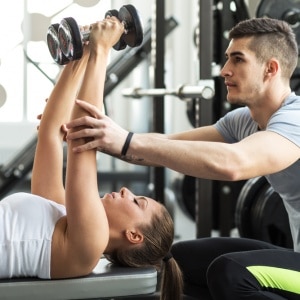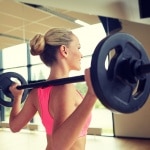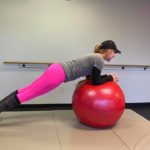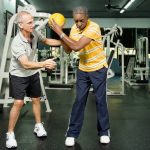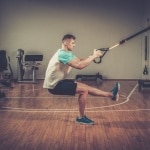
September 2020
Single- vs Multi-Joint Exercise: Order Matters
In resistance training, exercises are divided into single-joint (SJ) and multi-joint movements (MJ). SJ are where only one joint moves, like the elbow during a curl, while MJ are those where 2 or more joints move, like a chin up. Both use the biceps but the SJ does so in isolation.
A multi-national research group investigated the effects of a 10-week training program comparing SJ in isolation or combined with MJ, and in different orders, on the hypertrophy and strength of the triceps (Tri) and pectoralis major (chest muscle – PM). MJ strength (PM+Tri) was gaged by max bench press performance while SJ was gaged by a max supine triceps extension.
A total of 43 young male recreational exercisers but not lifters was divided into 4 groups: MJ, SJ, MJ+SJ, and SJ+MJ. Note the reverse order of the two latter groups. This way the order of exercises could be differentiated. MJ consisted of bench press; SJ of triceps extension. They all trained 2/wk.
Results showed that all groups increased strength consistent with the exercises they did, regardless of exercise order. While all had increased hypertrophy, those who did SJ first had slightly less growth of the PM compared to those who did bench press first (SJ+MJ vs MJ+SJ.) Tri saw more improvements when they were isolated (SJ, MJ+SJ, SJ+MJ) compared to when they were only one element of the MJ exercise. And all 3 heads of the triceps hypertrophied when they were combined with SJ and MJ exercises.
In sum, as long as the loads are high enough, exercise type (SJ v MJ) and order are not so relevant. However, SJ muscles get bigger and stronger when combined with MJ exercises.
JSCR May 2020
Do Prophylactic NSAIDs Improve Running Performance
Inflammation, the modern target for almost all things painful and disease, is managed with over-the-counter NSAIDs, non-steroidal anti-inflammatory drugs, by athletes and non-athletes alike, especially after challenging exercise. Some evidence suggests that they inhibit cellular mechanisms that actually contribute to repair and recovery from overuse and injury and may actually inhibit muscle adaptation to exercise.
Prior studies suggest they do not have benefits time to exhaustion, pain tolerance or lactate production. Yet ultra distance runners still use them to manage muscle and joint pain that impact performance during heavy exercise even though studies show they stress the kidneys.
A study from Brazil compared the physical performance, vertical jump ability, muscle biomarkers like creatine kinase (a marker of muscle damage) and lactate, pain, hydration status and some kidney functions pre- and post- a 42-km trail running event. Some used NSAIDs, others did not; not all finished the race.
Due to methodological limitations, like testing only 5 minutes post-race, they could not conclude anything about muscle damage markers or lactate accumulation though both were higher in both groups. However, the changes were similar in the controls as the experimental group suggesting NSAIDs don’t really help there.
The experimental group showed significant maintenance of jumping ability, suggesting that “ibuprofen may have attenuated fatigue by alleviating pain in the gastrocnemius (calf) muscle” based on self-reported pain by the runners. No firm conclusions could be drawn from this study regarding acute effects on the kidneys.
JSCR July 2020
Tid Bits
Osteoarthritis (OA), which is associated with aging and abuse of a joint, vs rheumatoid arthritis, which is an auto-immune disease, was thought to result from excessive activity like running. A JAMA Network Open (May 2020) analyzed 10 years’ data on 1194 adults to see if physical activity increased risk of OA. They found low to moderate amounts of activity (1-2 hrs/wk) of strenuous is actually protective against OA. Cleveland Clinic Arthritis Advisor Aug. 2020
A study on a sub-group of 370 subjects in the San Antonio Longitudinal Study of Aging (Int J of Geriatric Psychiatry, Apr. 2020) reported that slower gait speed may be related to cognitive decline. After testing for time and place orientation, attention, recall, language, etc., subjects were measured on how fast they could walk 10 feet. They were followed up 10 years later. Those who now walked at slower speeds at the outset had lower cognitive scores, with the slowest from 10 years ago showing the steepest declines. Those with more stable gait speeds had better cognition scores. Harvard Men’s Health Watch Aug. 2020
A NYT health and fitness article (July 1) referred to a study of two macaques monkeys trained to lift weights similar to doing one-hand pull ups. The Journal of Neuroscience (June 2020) study reported on how the researchers implanted transmitters and electrodes into nerve bundles of the reticulospinal (evolutionarily an ancient, reptilian, survival-based nerve system) and corticospinal (evolutionarily a newer system prevalent in mammals) tracts. The monkeys were ‘trained’ to use one hand to access treats with a lever system that gradually increased tension over time so they had to get stronger. Turns out that the primary neural stimulus for strength improvement came from the old reticulospinal tract, proof that survival depends on strength and our ability to gain it with training! (Self-serving but, hey, it’s science.)

